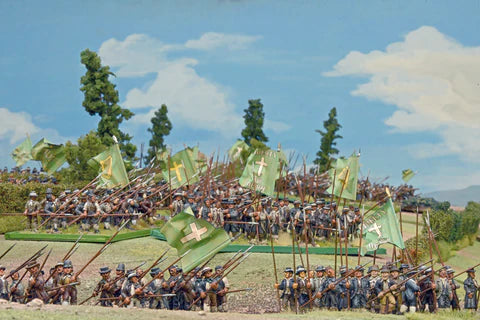The 1798 Irish Rebellion for Beginners - Part 1
The Trent Miniatures range contains a wide variety of wonderfully characterful models across a variety of warzones and time periods. This includes models from the Irish Rebellion, the Caribbean Rebellion and the French Revolution to name but a few.
If you would like to view the whole range of models available as part of the Trent Miniatures range click here.
This weeks blog post takes a look at the background of the 1798 Irish Rebellion.

The 1798 Irish Rebellion for Beginners - Part 1
In late December 1796, a French fleet carrying nearly 15,000 men, arrived in Bantry Bay in the south of Ireland. The French had come to assist a rebellious organisation called the “United Irishmen” who had been inspired by the successful rebellions in America and France and who hoped to emulate this success by overthrowing British rule and establishing a people’s republic in Ireland. Unfortunately for the rebels, the leaders of the French expedition had been blown off course by storms whilst the troops who had arrived were at a loss as to how to proceed with the invasion. When their leaders did not arrive, the French fleet departed and with them went the best chance to drive the British military out of Ireland.
The British Government in Dublin were shocked into action by this “near miss” and immediately began to arrest anyone connected to the “United Irishmen” and to seize arms and weapons held by those believed to hold rebel sympathies. With no hope of French aid and with their precious supplies and leaders being seized every day, the rebels decided to go for broke and start the rebellion. On the 24th May, 1798, rebels in Dublin stopped the Mail Coaches from leaving the city, whilst other rebel groups attempted to seize weapons from Government armouries. When the coaches carrying the post did not arrive in the various towns and villages around the country, the rebels recognised this as the sign that the rebellion had begun and immediately rose against government forces.
Within weeks, battles and skirmishes had happened across the country. The Government found that its forces were over stretched and extremely hard pressed to deal with the rebels. The British Government in London had few troops to send to Ireland, as most of the British regulars were committed in Europe or in the Colonies. Instead, units of Fencibles, Militia and even mercenaries had to be used to support the increasingly desperate Dublin authorities. However, many of the rebel leaders around the country, and especially in Dublin, had already been arrested, and so the rebellion lacked any central control or organisation. As a result, the risings were uncoordinated and sporadic. The first initial success was at the end of May in the southeast, when several thousand rebels rose in Wexford and successfully defeated Government troops at Enniscorthy before taking Wexford town. Risings then happened in the northeast in early June, with several skirmishes happening in County Antrim before the Government troops regained control. Local Rebellions broke out like wildfires around the country with the Dublin Government chasing its tail to stamp them out. Despite this initial success, the rebels soon began to run out of steam, especially when faced with the logistical challenges of keeping thousands of men in the field for weeks on end.

Why Wargame the 1798 Rebellion?
Unlike the 1745 Jacobite Rebellion in Scotland, which arguably saw only 4 battles during the whole campaign, the 1798 Irish Rebellion had over 30 sizable engagements and numerous smaller skirmishes during its five-month duration. This gives the gamer a much wider variety of battles and skirmishes to recreate on the table top without having to stray too far into “what if” territory.
Secondly, it has some lovely troop types and allows the wargamer to use British troops that are unique to this period, such as Militia, Fencibles, Yeoman and colourful mercenary units. Many of these were previously only ever used against smugglers or as local police forces, meaning wargamers have never had a chance to use them “in action.”
Finally, the forces are quite evenly balanced. The rebels won many of the historical encounters and their staying power against British regulars can be increased by the addition of regular French allies. Having hopefully piqued your interest, let’s look at each of these reasons in turn, starting with the lovely uniforms.

Thank you for reading this weeks blog post, remember to read next weeks post which will continue the review of the 1798 Irish Rebellion with a further look into the Uniforms of the time...

